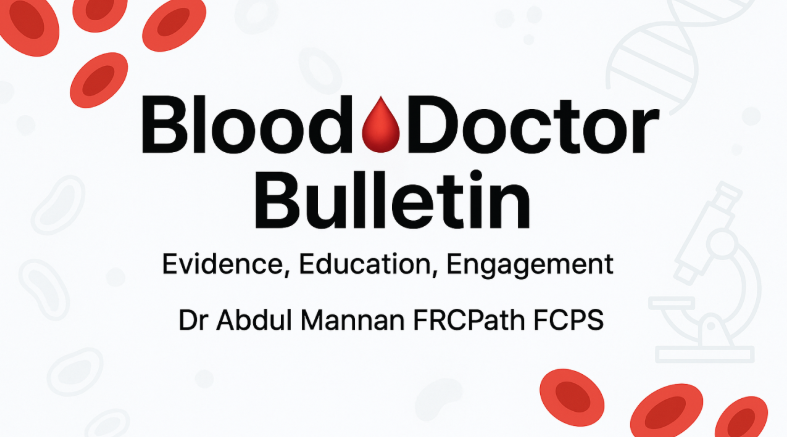
Abdul Mannan: Laboratory Alert – DOAC Interference in Heparin Monitoring
Abdul Mannan, Consultant Haematologist at Betsi Cadwaladr University Health Board, shared on LinkedIn:
“As thrombosis specialists, we’re increasingly encountering a sophisticated laboratory challenge that demands our immediate attention. The latest ISTH Scientific and Standardization Committee communication addresses a phenomenon that many of us have observed but perhaps haven’t fully systematized in our practice: DOAC interference with heparin anti-Xa monitoring.
- The Clinical Reality
In our daily practice, particularly in acute care settings, we frequently manage patients transitioning from DOACs to unfractionated heparin. Whether it’s perioperative bridging, critical illness management, or renal impairment scenarios, these transitions have become routine. However, what’s not routine is the laboratory interference that can significantly impact our clinical decision-making.
- The Science Behind the Interference
Pharmacokinetic Persistence: Recent evidence demonstrates that DOACs exhibit longer elimination half-lives than traditionally assumed, particularly in vulnerable populations:
– Rivaroxaban: Up to 39 hours
– Apixaban: Up to 52 hours
Laboratory Cross-Reactivity: Both DOACs and UFH register as anti-Xa activity in standard assays, creating an additive effect that can mislead our anticoagulation management. This isn’t merely a theoretical concern—it’s a daily reality affecting dosing decisions.
- Clinical Implications for Practice
For the Acute Care Setting:
When patients present with unexpectedly elevated anti-Xa levels despite conservative UFH dosing, DOAC interference should be our first differential diagnosis. This can lead to:
– Inappropriate withholding of necessary anticoagulation
– Underestimation of bleeding risk from residual DOAC activity
– Suboptimal thromboprophylaxis in high-risk patients
Risk Stratification Considerations:
Elderly patients, those with renal impairment, and individuals on interacting medications represent our highest-risk population for prolonged DOAC activity and subsequent monitoring interference.
- Practical Solutions for Modern Hemostasis Labs
Pre-analytical Strategies:
– Implement systematic DOAC history documentation
– Establish baseline anti-Xa measurements before UFH initiation
– Develop clear communication protocols between clinical and laboratory teams
Advanced Laboratory Techniques:
– DOAC removal systems (activated charcoal-based) show promise but require local validation
– Alternative monitoring approaches, including anti-IIa assays, merit consideration in specific scenarios
– Integration of DOAC-specific assays for confirmatory testing
- Building Robust Clinical Protocols
The heterogeneity in DOAC elimination demands individualized approaches rather than blanket protocols. Our clinical decision-making must integrate:
– Patient-specific pharmacokinetic factors
– Laboratory capabilities and validated methodologies
– Risk-benefit assessment for each transition scenario
Looking Forward
This communication represents more than a laboratory advisory—it’s a call for enhanced collaboration between clinicians, laboratory specialists, and pharmaceutical colleagues. As we advance our understanding of DOAC pharmacology and develop more sophisticated monitoring strategies, our patients will benefit from more precise anticoagulation management.
The evolution of our field demands that we remain vigilant to these emerging challenges while maintaining our commitment to evidence-based practice.
Discussion Point: How has your institution addressed DOAC-to-heparin transitions? What laboratory strategies have proven most effective in your practice?
For More: The full ISTH SSC communication provides detailed technical recommendations for laboratory implementation and clinical decision-making algorithms.
What challenges have you encountered in anticoagulation transitions? Share your experiences below.”
Stay updated with Hemostasis Today.
-
Nov 19, 2025, 18:03Andres Ricaurte Fajardo on a Strongyloides Stercoralis Hyperinfection with Thrombosis
-
Nov 19, 2025, 17:50Marilena Vrana Reflects on PPTA Europe’s Visits with Members and Stakeholders in 2025
-
Nov 19, 2025, 17:32Michael Makris Shares Insights from Global Forum Meeting of the WFH Meeting in Montreal
-
Nov 19, 2025, 17:14Yazan Abou Ismail Takes The Legacy Award from Qatar Foundation
-
Nov 19, 2025, 17:02Wolfgang Miesbach Shares Real-World Evidence on Eptacog Beta from Spain
-
Nov 19, 2025, 16:34Ishita Singh Reflects on Haematocon 2025: A Reminder of Her Commitment to The Journey
-
Nov 19, 2025, 16:23Mehdi Kashani: I’m Really Excited to Share Schistosite.com
-
Nov 19, 2025, 16:09A ”Meow-cyte” from Melaku Abay Muluneh or Why Microscopy Never Gets Old!
-
Nov 19, 2025, 15:56Cuilan Li on her Contribution to a Cutting-Edge Project in Polycythemia Vera
